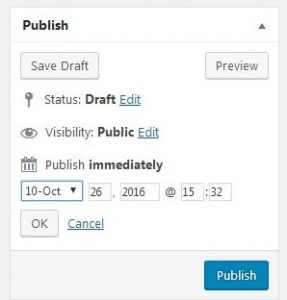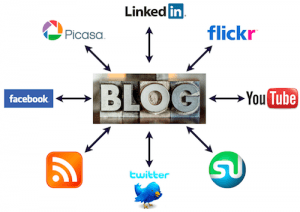 Monetize Your Blog Posts
Monetize Your Blog Posts
(This post is the fourth and final in a series on How to Update Your Blog. Be sure to read all four posts for the best results). Now we get to the fun part. Before we worry about prettying things up, let’s make sure this refreshed content will make us money. Ideally, each post and page on your website should serve a purpose. It could be that you’re growing a list, building a relationship with your readers, just plain entertaining them or selling them something.
For the purpose of this section of the report let’s assume you want to make a living from your blog. In that case, you need your readers to either sign up for your list so you can market to them via email, or make them an offer directly in the blog post.
If you chose to rework this particular blog post because you have the perfect product in mind to promote, this part will be easy. If not, take a few minutes and think about what the purpose of this particular post is. Do you want to encourage readers to sign up for your list? Or can you think of a product that would complement your content?
Take a few minutes to think about that and make a decision. Once you know what you want to promote or how you want to monetize your post, you can either write a call to action toward the end of your post, or work your recommendation directly into the content.
If growing your list is your goal, try adding a call to action and a signup form at the end of your post. This signup form can be different from the one you have in your blog sidebar. In fact, it should be so you can track where your signups are coming from. I find it helpful to craft a call to action that’s directly related to the content of the post.
Let me give you an example. Let’s say I have a blog about raising toddlers and this particular post was about recognizing when your toddler is ready to potty train. My call to action at the end of this particular post would be something along the lines of:
I hope this was helpful and I’d love to stay in touch. Of course, raising a toddler is about more than “just” potty training. Ready for more Toddler Tips? Enter your email below to sign up to the weekly Toddler Tips newsletter. I’ll also send you my ten best tips for dealing with temper tantrums.
Notice how the call to action flows from the content of the article to what the weekly newsletter and opt-in freebie are about?
Another option is of course to promote a product in your post. There are a few different ways to do this. By far the easiest method is to grab a graphic from the affiliate center (or a picture of your own product) and stick it right in the middle of your content. That’s also, by far, the least effective way to monetize your post. Another way you could monetize the post is by adding some code in there to display Google AdSense ads. Again, probably not your most effective way of monetizing your content – but it’s better than nothing.
Even better is to do something similar to what we did with the call to action to sign up for our list. Toward the end of your blog post, transition to a recommended product and let them know why you think it’s a good fit, or why you think they should buy it.
Better yet, make your recommendations right in the content itself. Once you do that, it starts to make sense to also incorporate product pictures. This is particularly easy to do if you are writing a blog post where you’re reviewing a product. As far as monetizing old content goes, it can still make sense to work product recommendations directly into the content itself.
Let’s go back to our potty training example. As you go through the various signs to look for that let you know that your toddler is ready to be potty trained, mention that now would be the perfect time to order a potty seat. Then move into a product recommendation for your favorite potty seat available on Amazon.com for example.
Ok, that’s enough potty talk for now. I hope you’ve gotten some good ideas about monetizing your blog posts. Have another look through the post you’re updating and figure out what you want to promote and how you want to monetize it.
If your primary goal is to grow your list, grab the code for a new opt-in form and write a strong call to action that invites readers to sign up.
If your main goal is to promote a related product, be it your own or something you’re an affiliate for, think about how you want to incorporate it into your content. Grab your link and product images as needed and work them in.
Now that the old blog post is better monetized, let’s move on to step five.
Make It Pretty
Now that we’ve updated the content and made sure it will make us money, let’s make sure it looks good when our visitors come and visit the udpated blog posts.
Add to Your Email Autoresponder Funnel
There’s one more step to the process. It’s a little more content marketing you can do to get your revived blog post the best chance of taking off and getting spread far and wide. It’s also an easy way to stay in touch with your email subscribers and if you monetized the post, make a few bucks right away.
It’s adding the revived blog post to your email funnel. You can do this in a few different ways.
- Send a quick email to your list to let them know you’ve updated the blog post. Invite them to click through and read it and ask them to leave you a comment.
- If you have an autoresponder set up, consider adding a similar message to it so all of your readers, no matter when they sign up for your list get to see all your messages (and all your important revived posts).
- If you create a weekly, bi-weekly or monthly newsletter, feature the revived post it in.
Again, the goal here is to start spreading the word about your content and get the ball rolling. Since everyone has multiple social media accounts these days, every single one of your subscriber has the potential of spreading your post to their own circle of influence. And all it takes is the right person to share it for it to get you a fair amount of traffic.
And all those social mentions and links will help with SEO (search engine optimization) as well for the long run.
Most importantly though, you want to share it because it is good content your readers will enjoy and find helpful. Your goal should always be to serve your audience and build a closer relationship with them. Only then will you find out how you can best help them and they will know, like and trust you enough to spend their money when you make a product recommendation.
Be sure to read all four posts in this series:
Updating Your Blog: Social Media Traffic to Your Blog
Updating Your Blog: Adding Images and Formatting
Updating Your Blog: Beginning Steps
And please leave a comment to share your thoughts and ideas and to connect with others who also have an interest in this topic.
 Do You Know How to Schedule Blog Posts?
Do You Know How to Schedule Blog Posts?

 Monetize Your Blog Posts
Monetize Your Blog Posts Social Media Traffic
Social Media Traffic Now we’re going to be talking about images. Pictures are a great way to add interest to a page and enhance the content. They are the perfect way to grab your reader’s attention. And in an age of Facebook and Pinterest, you have to have images in your blog posts.
Now we’re going to be talking about images. Pictures are a great way to add interest to a page and enhance the content. They are the perfect way to grab your reader’s attention. And in an age of Facebook and Pinterest, you have to have images in your blog posts. When is the Best Time to Publish Blog Posts?
When is the Best Time to Publish Blog Posts?